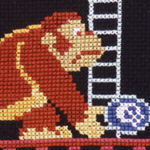
« PREVIOUS ENTRY
A wedding in need of a shotgun
NEXT ENTRY »
“Homeland Alert” software

I’m speechless with awe. Some intrepid hobbyist has created note-perfect renditions of classic 80s video games using needlepoint stitching patterns.
As astute readers may recall, I once posted about the way modern game-graphic techniques have borrowed from some of the tricks that ancient tapestry-designers used to employ. Specifically:
Early computer pioneers actually borrowed directly from the techniques of ancient artists. Consider “anti-aliasing”. Back when medieval tapestry weavers and Islamic tile-mosaic artists were doing their work in the 11th to 14th centuries, they innovated a neat technique for making edges appear more curved. If the artists were using black tiles to make a rounded corner, they’d insert a few grey ones in the crevices of right-angled parts — creating the illustion that the corner was smoother than it really was. That technique, anti-aliasing, was later used by Apple fontographers in the early 1980s, when they were trying to create smoother-looking edges on their fonts for the first WYSIWYG Macintosh computers.
But it never occurred to me to reverse the influence — and use the chunky pixellation of stitching to emulate video-game design. What a brave new world, that has such people in it!
(A tip of the hat to Memepool for finding this one!)
I'm Clive Thompson, the author of Smarter Than You Think: How Technology is Changing Our Minds for the Better (Penguin Press). You can order the book now at Amazon, Barnes and Noble, Powells, Indiebound, or through your local bookstore! I'm also a contributing writer for the New York Times Magazine and a columnist for Wired magazine. Email is here or ping me via the antiquated form of AOL IM (pomeranian99).

ECHO
Erik Weissengruber
Vespaboy
Terri Senft
Tom Igoe
El Rey Del Art
Morgan Noel
Maura Johnston
Cori Eckert
Heather Gold
Andrew Hearst
Chris Allbritton
Bret Dawson
Michele Tepper
Sharyn November
Gail Jaitin
Barnaby Marshall
Frankly, I'd Rather Not
The Shifted Librarian
Ryan Bigge
Nick Denton
Howard Sherman's Nuggets
Serial Deviant
Ellen McDermott
Jeff Liu
Marc Kelsey
Chris Shieh
Iron Monkey
Diversions
Rob Toole
Donut Rock City
Ross Judson
Idle Words
J-Walk Blog
The Antic Muse
Tribblescape
Little Things
Jeff Heer
Abstract Dynamics
Snark Market
Plastic Bag
Sensory Impact
Incoming Signals
MemeFirst
MemoryCard
Majikthise
Ludonauts
Boing Boing
Slashdot
Atrios
Smart Mobs
Plastic
Ludology.org
The Feature
Gizmodo
game girl
Mindjack
Techdirt Wireless News
Corante Gaming blog
Corante Social Software blog
ECHO
SciTech Daily
Arts and Letters Daily
Textually.org
BlogPulse
Robots.net
Alan Reiter's Wireless Data Weblog
Brad DeLong
Viral Marketing Blog
Gameblogs
Slashdot Games